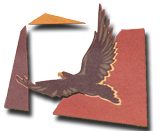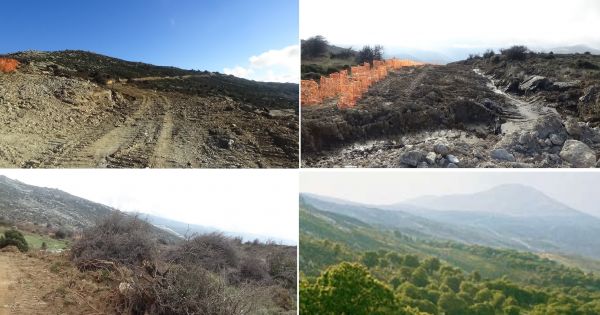Habitats
Habitats are regions with specific types of vegetation and geographical spreading. The habitats that are described by the directive 92/43 of E.E., constitute a criterion for the inclusion of a region under protection status. In the Ochi mountain area, there are more than 20 habitat types that have been recorded in the Specific Environmental Study (Oikos, 1998) which was worked out in order to assess the value of the area and to legislate its protection status from the Greek law.
Important habitats of Ochi
Sea bed areas with Posidonia oceanica plants: the marine habitat with Posidonia ('fikiathes' - alternative term used by fishermen) with priority protection index, consitute a biological index representing excellent condition of the ecosystem.
Ammonitrophilous (sand/nitrate ion loving) and ammophilous (sand loving) vegetation: two types of vetetation that we meet on seasides. The first type includes annual thin vegetation, whereas the second type includes perennial shrubs on flat areas or slopes of the coastal zone.
Steep rocky coasts: vegetation species like those from the Liminium genus that like salinity and rocks.
Foreshores with bulrush plants (Juncus spp.): Wet meadows with bulrush occur in Karystos plain ("Kampos") and in Potami location of Platanistos.
Vegetation with wild reed plant (Phragmites australis): dense reed vegetation that occur in the dikes of the Karystos plain, in the Potami location of Platanistos, in Phygia and elsewhere.
Rivers with periodic flow: the riparian (on the riverside) nitrophilous vegetation occurs by the Ochi creeks (Dimosaris, Platanistos ravines, Komito, Antia and others). Also, thickets with oleander and osier are found.
Sycamore forests (Platanus orientelis): Sycamore forests develop mainly by creeks that are distant from the sea. Old sycamore tufts occur on the Dimosaris gorge, whereas on the north slopes of 'Anatoli' peak, dwarf sycamore trees have developed, due to strong winds.
Brushwood: habitat that dominates in the arid and rocky places of Ochi. It includes broom brushes (Genista acanthoclada), bots (Sarcopoterium spinosum), heaths (Erica spp.), Jerusalem sage (Phlomis fruticosa), knapweed (Centaurea spinosa) and others.
Chestnut forests (Castanea sativa): valuable habitat due to its scarcity in Greece. 'Kastanolongos' (chestnut forest), the most extensive thicket of chestnut trees on the foot of the Ochi mountain, includes elderly trees. Other small thickets of chestnuts occur at very few spots around the summit of the Ochi mountain, as in Rouklia region. Ochi chestnuts are remnants of larger forests that were degraded due to fires and overgrazing.
Yew tree and Holly brush thickets: in the slate rocks of Iouda summit (1325 m.), isolated yew trees (Taxus bacata) occur that constitute a remnant of an ancient forest. Also, at a lower altitude we meet sporadic holly brush plants (Ilex aquifollium).
Forests and brush thickets with hard-leaved evergreens: a habitat with wide spread in the region of Ochi mountain that includes holly brushes (Quercus coccifera) and wild olive trees (Olea sylvestris) on low altitudes and holm oaks (Quercus ilex) on higher spots. This vegetation, also known as 'maquis' , on most of the occasions, has shrubby appearance, due to the fires and grazing. On hard-to-reach slopes, occur holly brushes having size similar to a tree and holm oaks that form dense forest, e.g. Vathirema (deep creek).
Pseudo-steppe habitats with therophytes and grasses: a habitat that includes grassland vegetation (eg, wild flowers, therophyta, grasses), frequently found with brush. Pseudo-steppes occur at intermediate and higher latitudes of the Ochi mountain and Cavo d'Oro region.
Eutrophicated ponds and Mediterranean seasonal marshes: concerning two artificial ponds that existed in the Karystos plain ('kampos') and they had developed into hygrotope ecosystem, but they underwent complete degradation with continuous rubble filling. The small pond in Psathi location is still preserved. The seasonal marshes have the form of wet meadows (alipedes) and occur close to the coastal zone of Karystos plain. The rubble fillings and the artibrary building have diminished the area and degraded the quality of the alipedes which once, used to be gathering location of migratory birds.





























